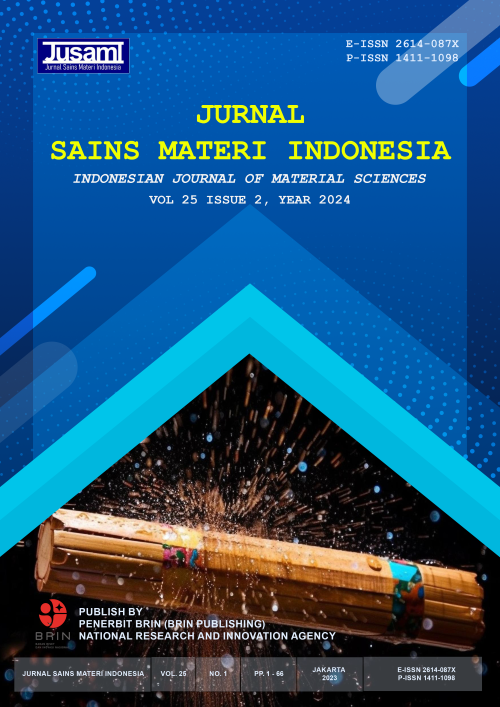Aluminum Waste as Electrode for Home Textile Industry Wastewater Treatment using Batch Electrocoagulation Process: Studies on Operating Parameters
DOI:
https://doi.org/10.55981/jsmi.2024.3120Keywords:
Electrocoagulation, Sasirangan textile wastewater, Color, COD, Aluminum electrode, wastewaterAbstract
The manufacture of the Sasirangan home textile industry involves coloring and dyeing processes using synthetic dyes in large quantities. These contaminants of dyes and organic materials would cause high color and chemical oxygen demand (COD) contaminants values. This study aims to characterize the wastewater of batik-modified Sasirangan and determine the effect of current density and length of operating time on color removal and reduction of COD in Sasirangan home textile industry wastewater through the batch electrocoagulation process. The method used in this research is an electric current flowing in the same direction to the Sasirangan home textile industry wastewater in a reactor with dimensions of 310 180 240 mm3. The electrode used is aluminum alloy type 1100. The aluminum/aluminum (Al/Al) electrode is used in this electrocoagulation (EC) process, then connected to a direct current (DC) power supply. The experiment was carried out at room temperature using an electrode distance of 2 cm with variations in the time of the electrocoagulation process for 15–120 minutes. The experiment was repeated for variations in pH (4–9) with a current density of 3.5–5.5 mA/cm2. Furthermore, an analysis of the color removal and the decrease in the concentration of COD was carried out. The results showed that the contaminant content in Sasirangan home textile industry wastewater decreased significantly, whereas the optimal conditions for the EC reaction were determined using color and COD removal efficiency parameters. The decrease in color and COD concentrations occurred at a current density of 5.5 mA/cm2 with a pH of 4 for 120 minutes, around 1110 PtCo and 90.4 mg/L of COD, respectively
Downloads
References
F.J. Ariza-Pineda, I.F. Macías-Quiroga, D.F. Hinojosa-Zambrano, J.D. Rivera-Giraldo, D.M. Ocampo-Serna, and N.R. Sanabria-González. “Treatment of textile wastewater using the Co(II)/NaHCO3/H2O2 oxidation system.” Heliyon, vol. 9, p. e22444, 2023.
S. Bener, Ö. Bulca, B. Palas, G. Tekin, S. Atalay, and G. Ersöz. “Electrocoagulation process for the treatment of real textile wastewater: Effect of operative conditions on the organic carbon removal and kinetic study.” Process Safety and Environmental Protection, vol. 129, pp. 47–54, 2019.
J.M. Bidu, K.N. Njau, M. Rwiza, and B. Van der Bruggen. “Textile wastewater treatment in anaerobic reactor: Influence of domestic wastewater as co-substrate in color and COD removal.” South African Journal of Chemical Engineering, vol. 43, no. 1, 112–121, 2023.
A. Negash, D. Tibebe, M. Mulugeta, and Y. Kassa. “A study of basic and reactive dyes removal from synthetic and industrial wastewater by electrocoagulation process.” South African Journal of Chemical Engineering, vol. 46, no. 1, 122–131, 2023.
S.S.A. Norrahma, N.H.A. Hamid, N.H.H. Hairom, L. Jasmani, and D.A.B. Sidik. “Industrial textile wastewater treatment using Neolamarckia cadamba NFC filter paper via cross-flow filtration system.” Journal of Water Process Engineering, vol. 55, p. 104188, 2023.
J. Núñez, M. Yeber, N. Cisternas, R. Thibaut, P. Medina, and C. Carrasco. “Application of electrocoagulation for the efficient pollutants removal to reuse the treated wastewater in the dyeing process of the textile industry.” Journal of Hazardous Materials, vol. 371, pp. 705–711, 2019.
S. Raj, H. Singh, and J. Bhattacharya. “Treatment of textile industry wastewater based on coagulation-flocculation aided sedimentation followed by adsorption: Process studies in an industrial ecology concept.” Science of The Total Environment, vol. 857, no. 2, p. 159464, 2023.
M. Sanavi Fard, A. Ehsani, and F. Soleimani. “Treatment of synthetic textile wastewater containing Acid Red 182 by electro-Peroxone process using RSM.” Journal of Environmental Management, vol. 344, p. 118379, 2023.
J.N. Hakizimana, B. Gourich, M. Chafi, Y. Stiriba, C. Vial, P. Drogui, and J. Naja. “Electrocoagulation process in water treatment: A review of electrocoagulation modeling approaches.” Desalination, vol. 404, pp. 1–21, 2017.
Y.G. Asfaha, F. Zewge, T. Yohannes, and S. Kebede. “Application of hybrid electrocoagulation and electrooxidation process for treatment of wastewater from the cotton textile industry.” Chemosphere, vol. 302, p. 134706, 2022.
A.S. Naje, S. Chelliapan, Z. Zakaria, M.A. Ajeel, and P.A. Alaba. “A review of electrocoagulation technology for the treatment of textile wastewater.” Reviews in Chemical Engineering, vol. 33, no. 3, pp. 263–292, 2017.
S. Boinpally, A. Kolla, J. Kainthola, R. Kodali, and J. Vemuri. “A state-of-the-art review of the electrocoagulation technology for wastewater treatment.” Water Cycle, vol. 4, pp. 26–36, 2023.
T. Rangseesuriyachai, K. Pinpatthanapong, J. Boonnorat, S. Jitpinit, T. Pinpatthanapong, and T. Mueansichai. “Optimization of COD and TDS removal from high-strength hospital wastewater by electrocoagulation using aluminium and iron electrodes: Insights from central composite design.” Journal of Environmental Chemical Engineering, vol. 12, no. 1, p. 111627, 2024.
M.E. Bote. “Studies on electrode combination for COD removal from domestic wastewater using electrocoagulation.” Heliyon, vol. 7, no. 12, p. e08614, 2021.
M. Nor El houda, M. Chabani, S. Bouafia-Chergui, and A. Touil. “Removal of chemical oxygen demand from real petroleum refinery wastewater through a hybrid approach: Electrocoagulation and adsorption.” Chemical Engineering and Processing - Process Intensification, vol. 196, p. 109680, 2024.
S. Najari, M. Delnavaz, and D. Bahrami. “Application of electrocoagulation process for the treatment of reactive blue 19 synthetic wastewater: Evaluation of different operation conditions and financial analysis.” Chemical Physics Letters, vol. 832, p. 140897, 2023.
A. Yaqub, H. Raza, H. Ajab, S.H. Shah, A. Shad, and Z.A. Bhatti. “Decolorization of reactive blue-2 dye in aqueous solution by electrocoagulation process using aluminum and steel electrodes.” Journal of Hazardous Materials Advances, vol. 9, p. 100248, 2023.
MOEF, Wastewater effluent standard for industries, Decree No. 19, The Indonesian Ministry of Environment and Forestry, Jakarta, Indonesia, 2019.
C.E. Barrera-Díaz, P. Balderas-Hernández, and B. Bilyeu. “Chapter 3-Electrocoagulation: Fundamentals and Prospectives,” in: C.A. Martínez-Huitle, M.A. Rodrigo, O. Scialdone (Eds.), Electrochemical Water and Wastewater Treatment, Butterworth-Heinemann, 2018, pp. 61–76.
M.Y.A. Mollah, P. Morkovsky, J.A.G. Gomes, M. Kesmez, J. Parga, and D.L. Cocke. “Fundamentals, present and future perspectives of electrocoagulation.” Journal of Hazardous Materials, vol. 114, no. 1–3, pp. 199–210, 2004.
P. Asaithambi, M.B. Yesuf, R. Govindarajan, P. Selvakumar, S. Niju, T. Pandiyarajan, A. Kadier, D.D. Nguyen, and E. Alemayehu. “Industrial wastewater treatment using batch recirculation electrocoagulation (BRE) process: Studies on operating parameters.” Sustainable Chemistry for the Environment, vol. 2, p. 100014, 2023.
S. Garcia-Segura, M.M.S.G. Eiband, J.V. de Melo, and C.A. Martínez-Huitle. “Electrocoagulation and advanced electrocoagulation processes: A general review about the fundamentals, emerging applications and its association with other technologies.” Journal of Electroanalytical Chemistry, vol. 801, pp. 267–299, 2017.
A. Kothai, C. Sathishkumar, R. Muthupriya, K.S. sankar, and R. Dharchana. “Experimental investigation of textile dyeing wastewater treatment using aluminium in electro coagulation process and Fenton’s reagent in advanced oxidation process.” Materials Today: Proceedings, vol. 45, no. 2, pp. 1411–1416, 2021.
N. Adhoum and L. Monser. “Decolourization and removal of phenolic compounds from olive mill wastewater by electrocoagulation.” Chemical Engineering and Processing: Process Intensification, vol. 43, no. 10, pp. 1281–1287, 2004.
R. Niazmand, M. Jahani, and S. Kalantarian. “Treatment of olive processing wastewater by electrocoagulation: An effectiveness and economic assessment.” Journal of Environmental Management, vol. 248, p. 109262, 2019.
M. Nasrullah, S. Ansar, S. Krishnan, L. Singh, S.G. Peera, and A.W. Zularisam. “Electrocoagulation treatment of raw palm oil mill effluent: Optimization process using high current application.” Chemosphere, vol. 299, p. 134387, 2022.
B. Karagozoglu and R. Malkoc. “The investigation of the removal of reactive orange 16 DYE from textile wastewater by using electrocoagulation process. Cumhuriyet Science Journal, vol. 38, no. 3, pp. 544–556, 2017.
Downloads
Published
How to Cite
Issue
Section
License
Copyright (c) 2024 Chairul Irawan, Ridhayanti Mu'minah, Agita Purnawilda, Iryanti Fatyasari Nata

This work is licensed under a Creative Commons Attribution-ShareAlike 4.0 International License.








